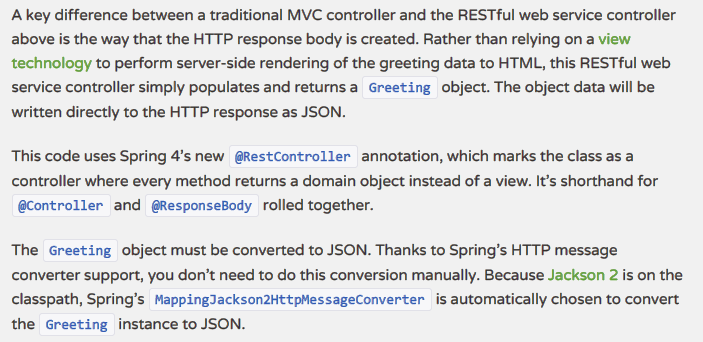Spring Boot - fish
1. @RestController combines @Controller and @ResponseBody, 这是不是意味着不用再import jakson的包(@ResponseBody时用到的,将对象转成json对象)了? 有待考证。
2. Create an Application class
1 package hello; 2 3 import java.util.Arrays; 4 5 import org.springframework.boot.SpringApplication; 6 import org.springframework.boot.autoconfigure.SpringBootApplication; 7 import org.springframework.context.ApplicationContext; 8 9 @SpringBootApplication 10 public class Application { 11 12 public static void main(String[] args) { 13 ApplicationContext ctx = SpringApplication.run(Application.class, args); 14 15 System.out.println("Let's inspect the beans provided by Spring Boot:"); 16 17 String[] beanNames = ctx.getBeanDefinitionNames(); 18 Arrays.sort(beanNames); 19 for (String beanName : beanNames) { 20 System.out.println(beanName); 21 } 22 } 23 24 }
以上代码,调用annotation @SpringBootApplication,它会加载@Configuration,@EnableAutoConfiguation,@ComponentScan
其中,@Configuration:标记该class是ApplicationContext的一个bean定义,相当于原来applicationContext.xml文件中的<bean>标签。
@EnableAutoConfiguation:标记Spring Boot开始加载各种beans(包括自定义的,classpath中的),以及各种属性。
@ComponentScan:告知Spring去搜索其他组件,配置或者服务。其实就是原来applicationContext.xml文件中的<mvc:component-scan>标签。
另外,由以上分析,个人认为在Spring Boot中,实际上是通过各种annotation来代替.xml配置文件中的各种配置,从而将xml文件干掉。
针对Spring MVC应用,本应该需要注解@EnableWebMvc,但是当Spring Boot在classpath中看到spring-webmvc时,就会自动加载该注解,激活DispatcherServlet等。
问题:对DispatcherServlet的配置,如何通过Spring Boot来配置呢?
--------------------------------------------------------------------------------------
通过对 Spring Boot中 Building a RESTful Web Service 这一章节的阅读,有以下理解:
首先,解决问题一:@RestController combines @Controller and @ResponseBody......
仍然需要import jakson的包,因为spring并没有提供将java Object转成JSON对象的package。
但spring提供MappingJackson2HttpMessageConverter,从而通过监测到jakson的包而自动加载并使用。最终将java Object转成JSON对象并附于HTTP response。
其次,如下:
1 package hello; 2 3 import java.util.concurrent.atomic.AtomicLong; 4 import org.springframework.web.bind.annotation.RequestMapping; 5 import org.springframework.web.bind.annotation.RequestParam; 6 import org.springframework.web.bind.annotation.RestController; 7 8 @RestController 9 public class GreetingController { 10 11 private static final String template = "Hello, %s!"; 12 private final AtomicLong counter = new AtomicLong(); 13 14 @RequestMapping("/greeting") 15 public Greeting greeting(@RequestParam(value="name", defaultValue="World") String name) { 16 return new Greeting(counter.incrementAndGet(), 17 String.format(template, name)); 18 } 19 }

终于明白@RequestMapping, @ResponseBody的用意和区别了。
可以说,@ResponseBody是为RESTful web service服务的。正如上所述,traditional mvc controller和RESTful web service controller之间的区别主要在于HTTP响应体的创建方式。
前者应用在Spring中,具体表现为在处理请求后,展示数据将存于map/modelMap/viewAndModelMap中,返回的是String/void类型(String则表示view的名称),再通过view技术对model数据进行渲染。
后者则不同,而是将展示数据存于自定义的对象中,并返回该对象,最终将该对象转成JSON对象附于HTTP响应体上。类似于MVC被VC替代了。
在Spring 4中,增加了@RestController注解,它是@Controller和@ResponseBody的结合。用于标记该类中的所有方法将返回一个自定义对象,而非视图。所以,当需要Controller既返回view又返回对象时,就不能使用@RestController了。



